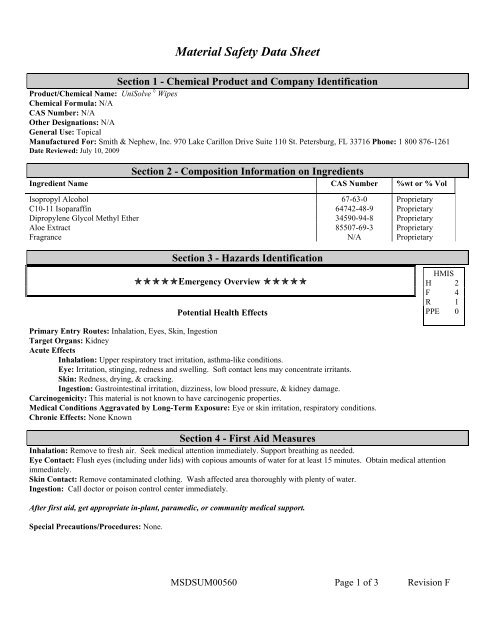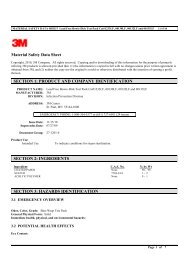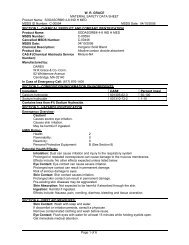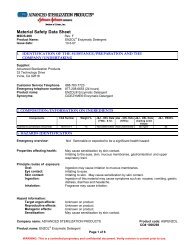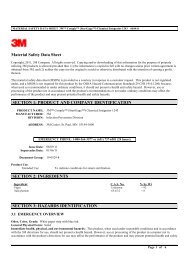Material Safety Data Sheet - Cardinal Health DFU/MSDS
Material Safety Data Sheet - Cardinal Health DFU/MSDS
Material Safety Data Sheet - Cardinal Health DFU/MSDS
You also want an ePaper? Increase the reach of your titles
YUMPU automatically turns print PDFs into web optimized ePapers that Google loves.
<strong>Material</strong> <strong>Safety</strong> <strong>Data</strong> <strong>Sheet</strong><br />
Section 1 - Chemical Product and Company Identification<br />
Product/Chemical Name: UniSolve ◊ Wipes<br />
Chemical Formula: N/A<br />
CAS Number: N/A<br />
Other Designations: N/A<br />
General Use: Topical<br />
Manufactured For: Smith & Nephew, Inc. 970 Lake Carillon Drive Suite 110 St. Petersburg, FL 33716 Phone: 1 800 876-1261<br />
Date Reviewed: July 10, 2009<br />
Section 2 - Composition Information on Ingredients<br />
Ingredient Name CAS Number %wt or % Vol<br />
Isopropyl Alcohol 67-63-0 Proprietary<br />
C10-11 Isoparaffin 64742-48-9 Proprietary<br />
Dipropylene Glycol Methyl Ether 34590-94-8 Proprietary<br />
Aloe Extract 85507-69-3 Proprietary<br />
Fragrance N/A Proprietary<br />
Section 3 - Hazards Identification<br />
Emergency Overview <br />
Potential <strong>Health</strong> Effects<br />
HMIS<br />
H 2<br />
F 4<br />
R 1<br />
PPE 0<br />
Primary Entry Routes: Inhalation, Eyes, Skin, Ingestion<br />
Target Organs: Kidney<br />
Acute Effects<br />
Inhalation: Upper respiratory tract irritation, asthma-like conditions.<br />
Eye: Irritation, stinging, redness and swelling. Soft contact lens may concentrate irritants.<br />
Skin: Redness, drying, & cracking.<br />
Ingestion: Gastrointestinal irritation, dizziness, low blood pressure, & kidney damage.<br />
Carcinogenicity: This material is not known to have carcinogenic properties.<br />
Medical Conditions Aggravated by Long-Term Exposure: Eye or skin irritation, respiratory conditions.<br />
Chronic Effects: None Known<br />
Section 4 - First Aid Measures<br />
Inhalation: Remove to fresh air. Seek medical attention immediately. Support breathing as needed.<br />
Eye Contact: Flush eyes (including under lids) with copious amounts of water for at least 15 minutes. Obtain medical attention<br />
immediately.<br />
Skin Contact: Remove contaminated clothing. Wash affected area thoroughly with plenty of water.<br />
Ingestion: Call doctor or poison control center immediately.<br />
After first aid, get appropriate in-plant, paramedic, or community medical support.<br />
Special Precautions/Procedures: None.<br />
<strong>MSDS</strong>UM00560 Page 1 of 3 Revision F
Section 5 - Fire-Fighting<br />
Flash Point: 63 o F / 17 o C<br />
Flash Point Method: TCC<br />
Burning Rate: N/A<br />
Autoignition Temperature: Not determined<br />
LEL (% vol. in air): Not determined<br />
UEL (% vol. in air): Not determined<br />
Flammability Classification: Flammable Liquid Class IB<br />
Extinguishing Media: Water spray, carbon dioxide, dry chemical foam.<br />
Unusual Fire or Explosion Hazards: Vapors are heavier than air and may travel to an ignition<br />
source and flashback.<br />
Hazardous Combustion Products: None known<br />
Fire-Fighting Instructions: Do not release runoff from fire control methods to sewers or waterways.<br />
Fire-Fighting Equipment: Self Contained Breathing Apparatus and protective clothing should be worn.<br />
NFPA:<br />
1<br />
3<br />
0<br />
0<br />
Section 6 - Accidental Release Measures<br />
Spill /Leak Procedures:<br />
Small Spills: Absorb spill on Vermiculite.<br />
Large Spills<br />
Containment: Dike spills to minimize contamination and contain material<br />
Cleanup: Eliminate ignition sources. Stop source of spill. Prevent from entering sewer, drains, & other bodies of water. Pump<br />
spilled liquid into clean container.<br />
Regulatory Requirements: Follow applicable OSHA regulations (29 CFR 1910.120).<br />
Section 7 - Handling and Storage<br />
Handling Precautions: Avoid prolonged skin contact. Wash thoroughly after handling. Do not get into eyes. Do not swallow.<br />
Storage Requirements: Store in a cool dry place,
Section 10 - Stability and Reactivity<br />
Stability: Stable<br />
Polymerization: Hazardous polymerization will not occur.<br />
Chemical Incompatibilities: Strong oxidizers<br />
Conditions to Avoid: Strong oxidizers & all heat & ignition sources.<br />
Hazardous Decomposition Products: carbon dioxide, carbon monoxide, & hydrocarbons.<br />
Section 11 - Toxicological Information<br />
Toxicity <strong>Data</strong>:<br />
Eye Effects: None known<br />
Chronic Effects: None known<br />
Skin Effects: None<br />
Carcinogenicity: None known<br />
Acute Inhalation Effects: None known<br />
Mutagenicity: None<br />
Acute Oral Effects: Moderately toxic<br />
Teratogenicity: None known<br />
Section 12 - Ecological Information<br />
Ecotoxicity: Not determined<br />
Environmental Fate: Not determined<br />
Environmental Degradation: Not determined<br />
Soil Absorption/Mobility: Not determined<br />
Section 13 - Disposal Considerations<br />
Disposal: Contact your supplier or a licensed contractor for detailed recommendations. Follow applicable federal, state, and local<br />
regulations.<br />
Disposal Regulatory Requirements: None known for normal use<br />
Container Cleaning and Disposal: Discard in suitable trash container<br />
EPA Regulations: None known for normal use<br />
OSHA Regulations: None known for normal use<br />
State Regulations: May vary from state to state<br />
Section 14 - Transport Information<br />
DOT Transportation <strong>Data</strong> (49 CFR 172.101):<br />
Not Regulated<br />
Section - 15 Regulatory Information<br />
Section 16 - Other Information<br />
Additional Hazard Rating Systems: None Known<br />
<strong>MSDS</strong>UM00560 Page 3 of 3 Revision F


